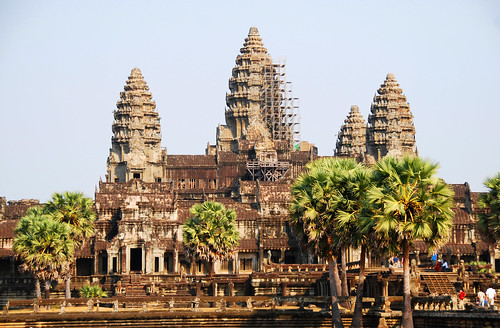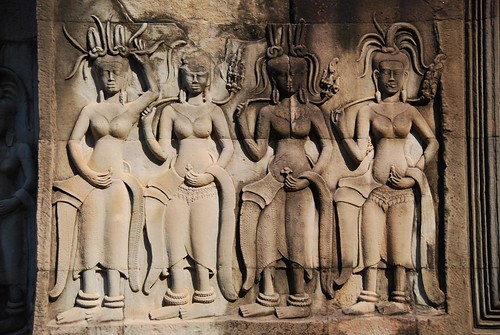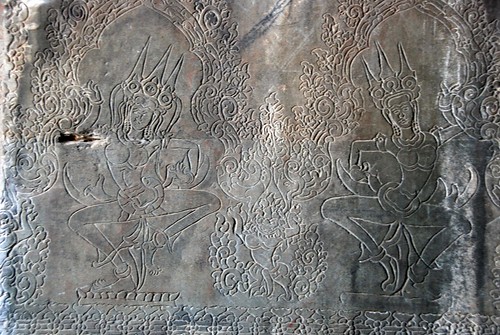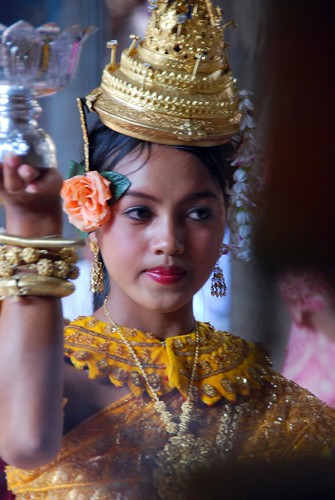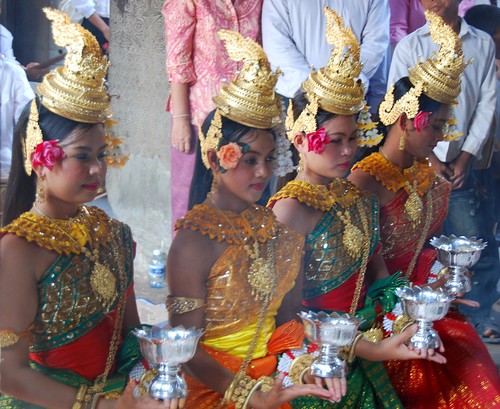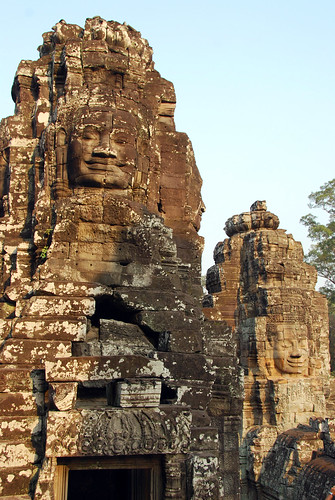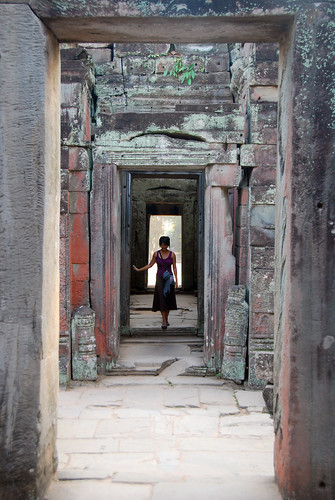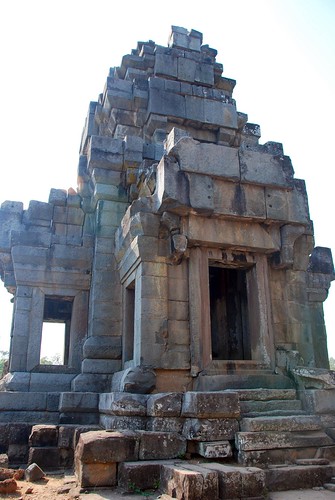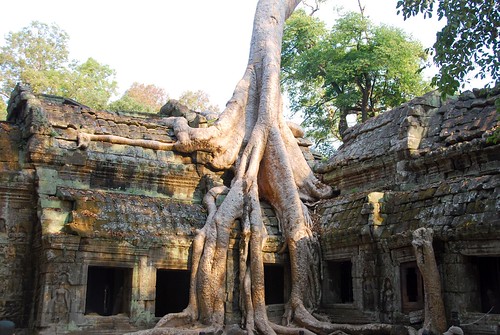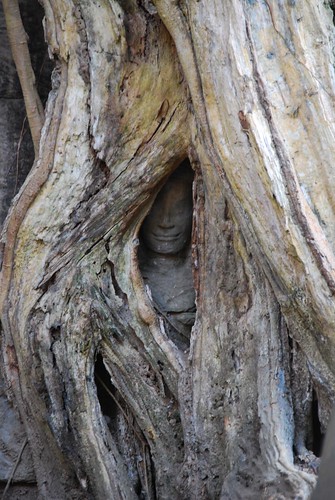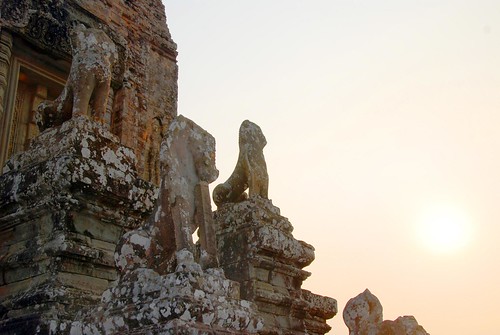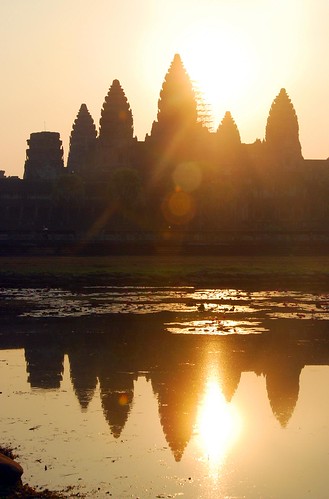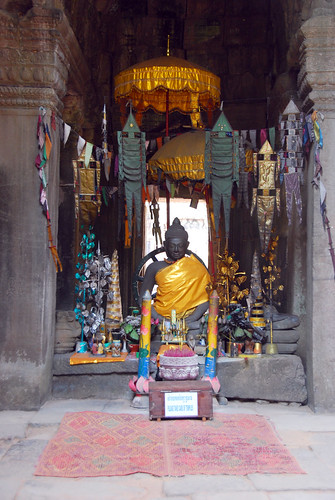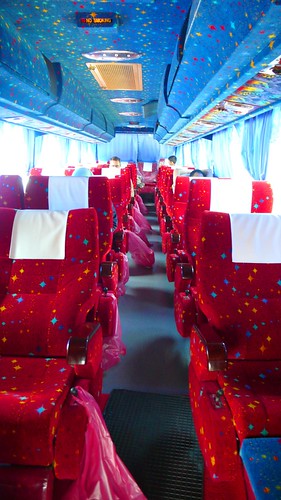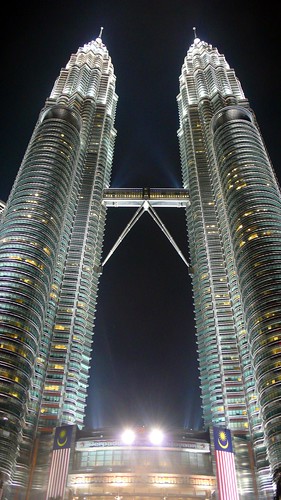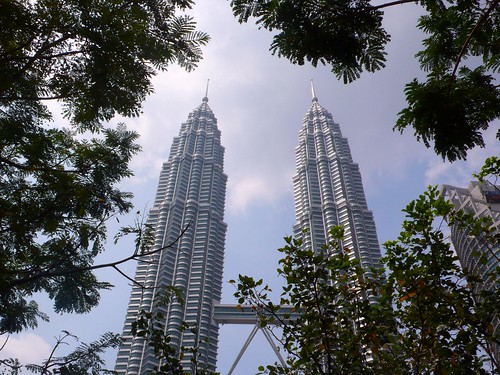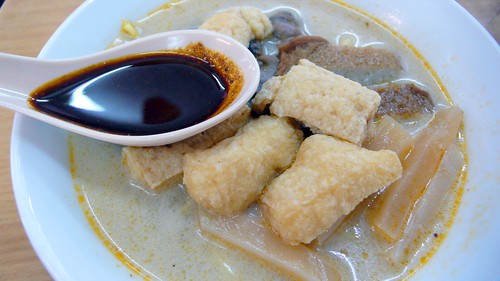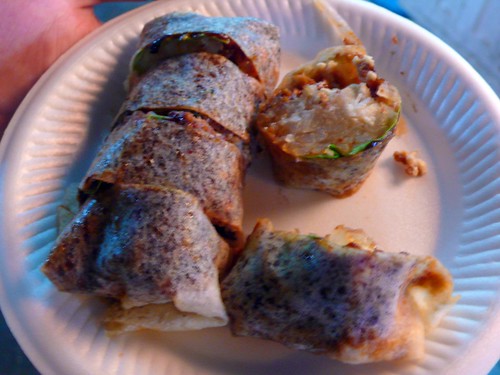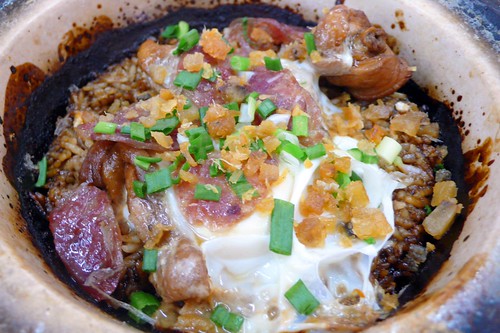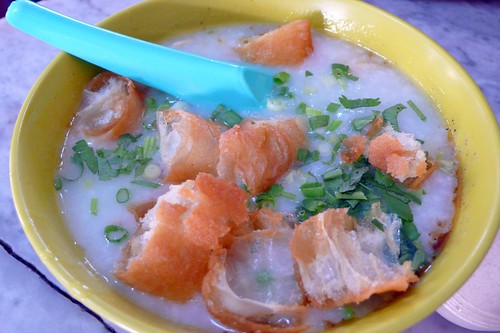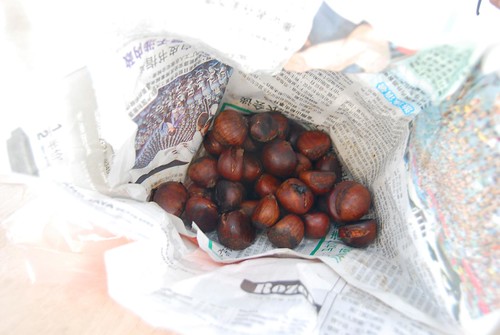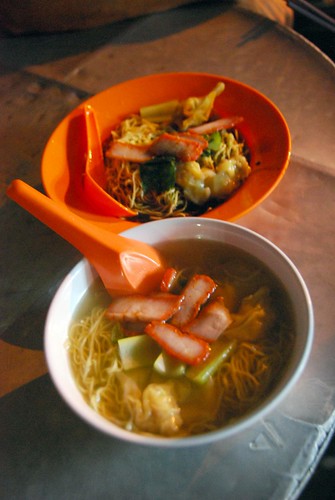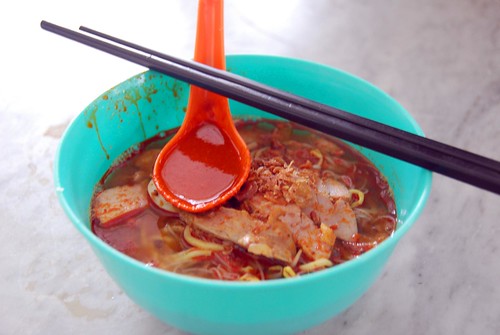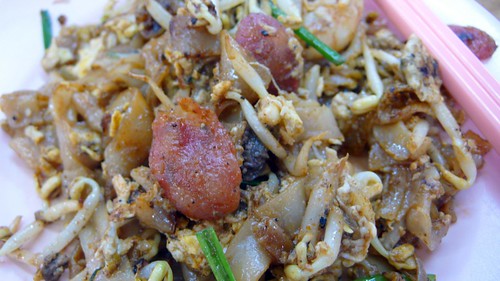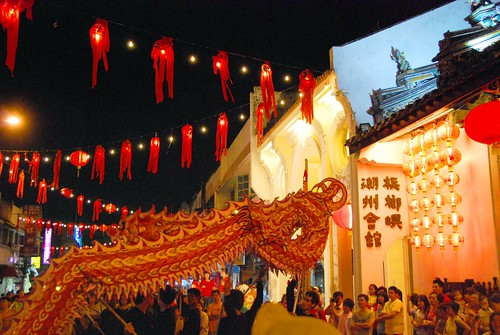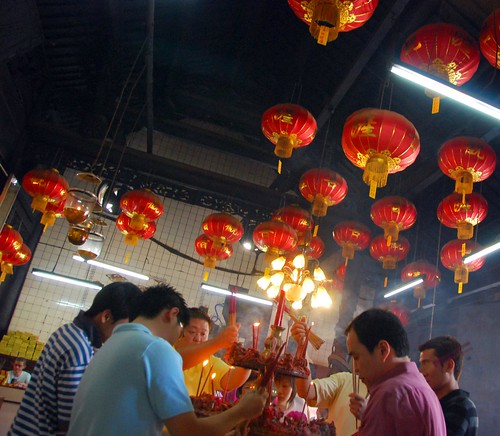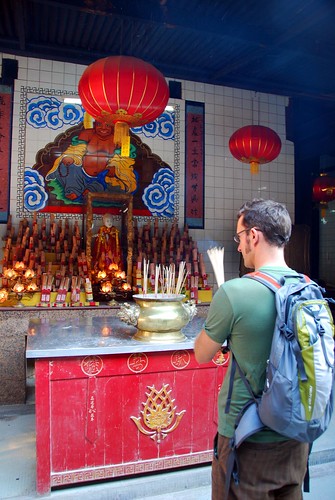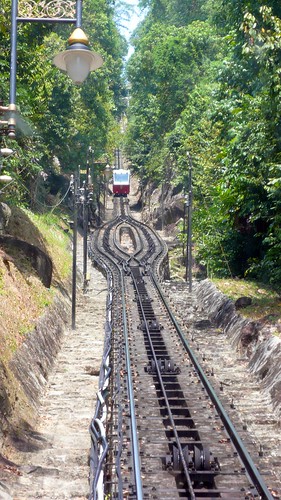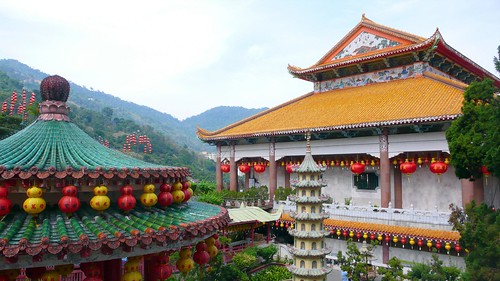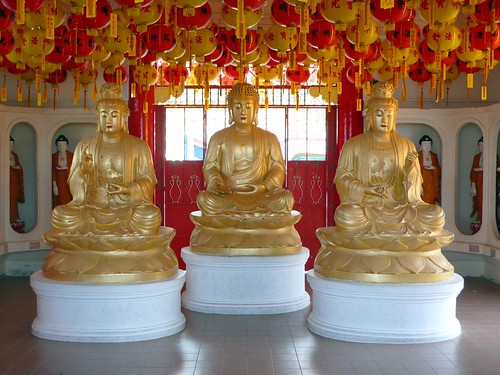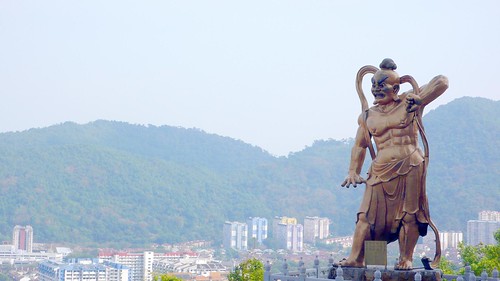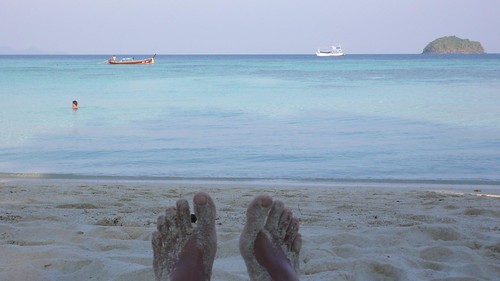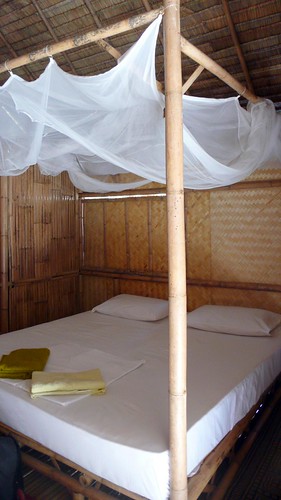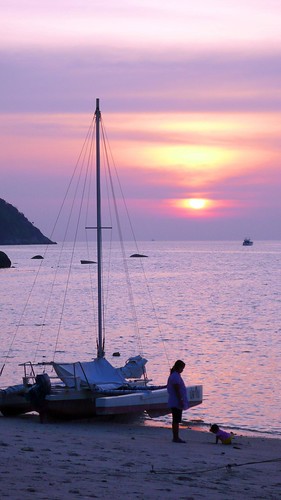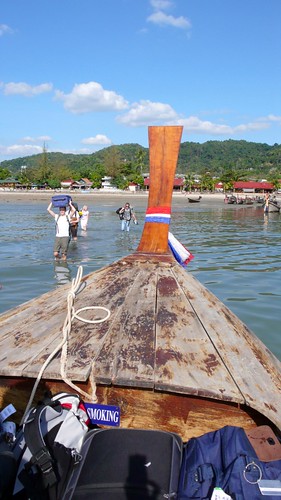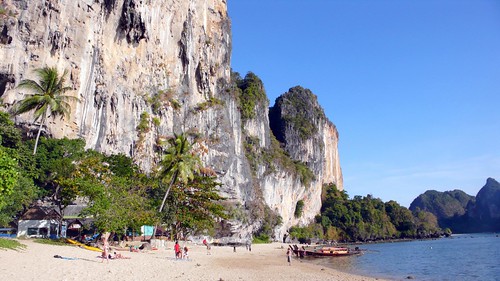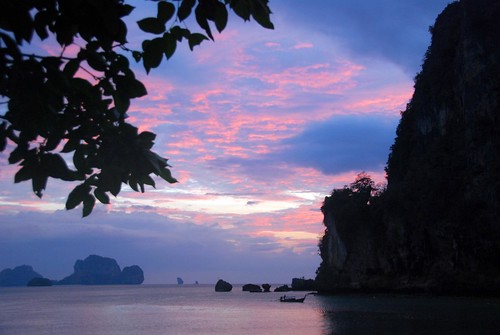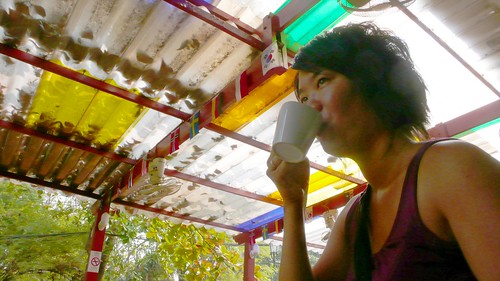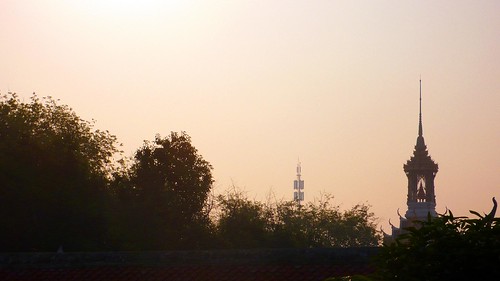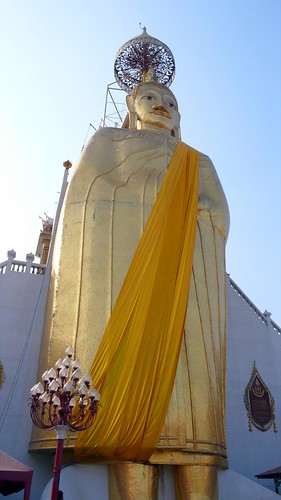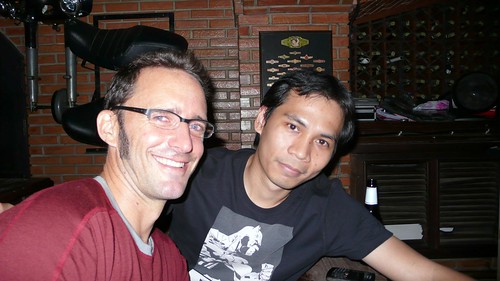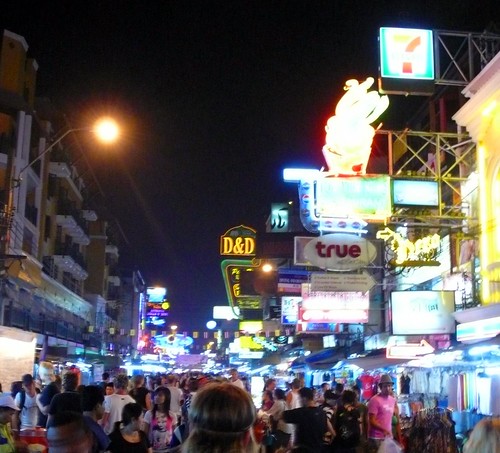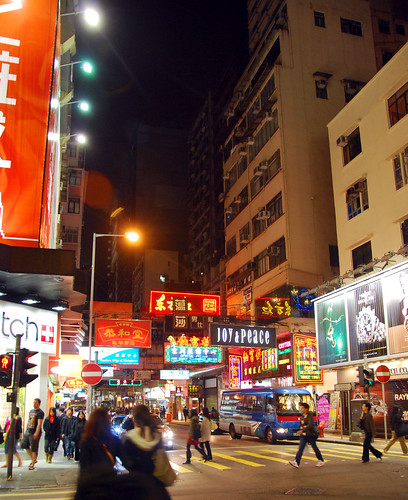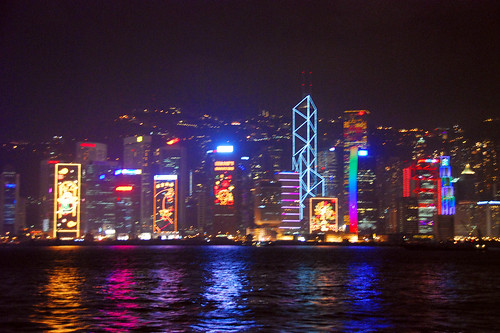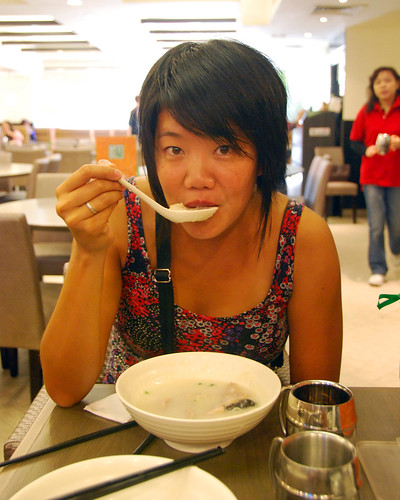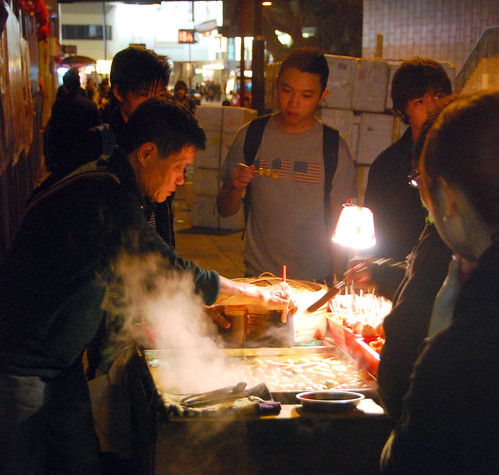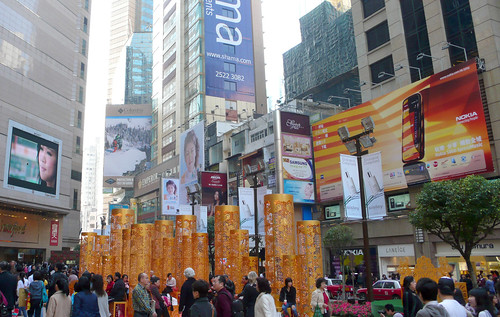Archive for February, 2009
If southern Thailand was all about relaxation and Malaysia was all about food, then Cambodia is definitely the place of contrasts and extremes. Whereas Siem Reap and the temples of Angkor celebrate Cambodian creativity, spirituality, and diligence, Phnom Penh seems like a city that is trying to move on from the many horrors of the Khmer Rouge and rule under Pol Pot, but is still faced the realities of that dark period every day.
On the bus from Siem Reap to Phnom Penh (more on that adventure later), I was deeply involved in the book First They Killed My Father by Luong Ung, a story of a middle-class Cambodian family that was torn apart during Communist rule. It is a first-hand account of what happened to many people during Pol Pot’s regime: hard labor, starvation, and genocide. Cambodian people of all ages were sent to work in the countryside, growing and harvesting rice, so that Pol Pot’s ridiculous goal of tripling the country’s rice production could be achieved. Field leaders sent off the bulk of their crop for export rather than admit that they could not reach the harvest goal, and the people working in the fields went hungry. There was no medicine, no school—even the family unit was seen as a relic of the bourgeois past. I almost cried a couple of times reading that book, and I felt very lucky—not only that people of our generation have never had to suffer through a regime change like that, but that the US has not had to deal with the effects of an extended war on our own soil for over 150 years.
Phnom Penh is strange because the major tourist attractions there are S21 or Tuol Sleng prison (where political prisoners were tortured and held captive), the Killing Fields (where the same prisoners were taken to be exterminate and dumped in mass graves), and…the Royal Palace. Right there is a study in contrasts: the atrocities of the Khmer Rouge set against the opulence of the King’s Palace. It’s also really disconcerting just walking on the street. In every city in SE Asia, there are tuk-tuk, taxi, cyclo, and motorbike drivers harassing you to take a ride with them, but in Phnom Penh, they come up and say: “Killing field? You want go killing field? Only $10! Good price for you!” We fully recognize the weirdness inherent in turning two sites of some of the world’s worst genocide into tourist attractions, and we’re still not really sure how to feel about this. On the one hand, it is definitely a good thing to educate people on what happened here. At the time, I am not sure if there was a lot of attention on Cambodia from the States because the US was focused on the Vietnam War (and in fact, the US bombed Cambodia during war in order to root out the Vietcong who were hiding there). Also, I suppose it is a good thing that the Cambodian people can turn a horrible experience into one that will bring money into their economy. Of course, when we found out that the Cambodian government essentially sold the Killing Fields to the Japanese (who now manage the site), we had to examine our thinking…
We visited both the Killing Fields and Tuol Sleng prison, and both of us felt that the prison was by far the more powerful of the two. First of all, it was formerly a school, so the settings were very institutional, which made the whole thing even more disturbing. You begin the visit in one building, where each room is set up with a single bed, perhaps some chains, and a photo on the wall of a prisoner in one of these beds after a “questioning session” (I cropped out the photo on the wall in the picture below for obvious reasons). It is shocking and moving and horrifying all at once, and the place is made even more eerie by the fact that everyone is shuffling through these rooms in complete silence.

Torture room at Tuol Sleng Prison Museum (S21).
In the next building, you come face to face with the people who suffered in this awful place—there are large bulletin boards with black and white photos of prisoners who once lived here. Some of them look defiant, some of them look like they have already given up, and all of them look like ghosts.

The faces of Tuol Sleng.
One of the most interesting exhibits at Tuol Sleng was a series of photographs taken by a Swedish man who visited Cambodia during Pol Pot’s rule. He was escorted around the country (along with 9 other Swedish delegates) by the Khmer Rouge, and the Communists essentially put on a show for the Swedes, in order to display the “success” of the Communist experiment in Cambodia. At the time, like some liberal Europeans and Americans, this Swedish man supported Communism and desperately wanted to see it work, so he bought the whole dog-and-pony show hook, line, and sinker. He has since seen the error of his ways and the exhibit starts with a letter of apology from him; he laments his mistakes and asks for forgiveness. Each room contains photos from his trip and is captioned by what he thought then (during the tour), and what he thinks now of the things he was shown. Part of the reason why we thought Tuol Sleng was more powerful than the Killing Fields was this human face that was put on the story, both from within (the faces on the bulletin boards) and from the outside (the Swedish man’s photo exhibit).
The Killing Fields is about 15 km outside of the busy city of Phnom Penh, set in the countryside. The peaceful surrounds made it was difficult for us to imagine the horrors that happened here, despite the fact that the walkway is still littered with pieces of clothing and even bones from the victims (very heavy). I’m not sure if this admission makes us seem like heartless cads, but it’s the truth, and perhaps it is just a byproduct of our safe and protected lives growing up in the US that we can’t even imagine a political power inflicting this type of atrocity on its own people.
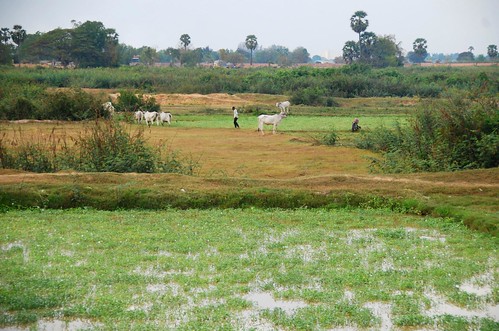
The Cambodian countryside near the Killing Fields.
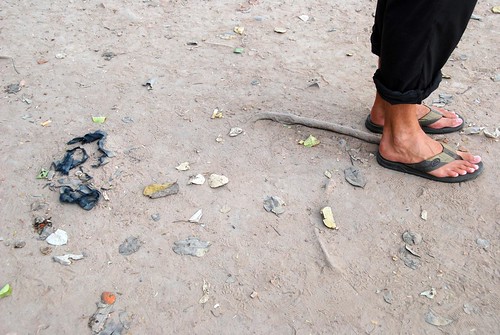
Bits of clothing still buried underfoot at the Killing Fields.
To sum it up, our experience of Cambodia was different than other parts of SE Asia because our feelings about it were never simple, like “I love this place!” or “I don’t really like this place.” More often our thoughts ran more along the lines of “I like this place but this part of it is disturbing to me” (Siem Reap), or “This place should really be challenging me but I am not reacting to it the way I should be and what does that say about me as an outsider?” (the Killing Fields). In other words, Cambodia was complicated. And I have to admit, I don’t think it should be any other way.
In general, I would say that SE Asia has been a challenge. Not in the literal way, because travel here is quite easy, but it’s just never what we expect. Each country we have visited so far on this trip teaches us something different about ourselves. In New Zealand, we were finding our groove, changing our routine and finding a new one in a different land. In Australia, I was learning how to find peace in an uncluttered day, getting accustomed to a life without endless to-do lists and never-ending projects (I realize this sounds silly, but it was a major change that took some getting used to). SE Asia has been all about never expecting one thing because then we will surely get the other. So thanks, Cambodia, for keeping us on our well-traveled toes.
Our next stop after KL was Siem Reap in Cambodia, a medium-sized town close to the Temples of Angkor. We (finally!) decided on a travel plan: we will travel through Cambodia, cross over to Vietnam in the south, eventually hitting Hanoi in the north, where we will cross over to Laos, and then travel to northern Thailand from there. At that point, we will either make our way back to Bangkok before heading to Malaysian Borneo to dive, or we will fly straight from Chang Mai in northern Thailand. It feels good to have a plan, even if it is a loose one, and we are still keeping our eyes and ears open for travel suggestions from friends and other travelers.
We flew from KL to Siem Reap for about 335 ringgit (approx. US$95) each (again, AirAsia). It was quite convenient because they issue visas right at the airport (US$20 per person) in Siem Reap. Immigration officials wanted payment in US dollars, and luckily, ATMs at the airport only dispense US dollars. We would come to find out that all of our financial transactions in Cambodia would be done in US currency, but they use Cambodian rials as “coins” (they are actually bills, but if you buy something that costs less than a dollar, you purchase it with rials). It works out quite well because the exchange rate is currently about US$1=1600 rials, so $0.25 is 400 rials. We tried to buy a bottle of water for $0.50 and I busted out some quarters that I had been carrying around since we left the States. The vendor looked quizzically at the quarters and then examined them like they were exotic gems: he had never seen US coins before.
On a recommendation from Jeremy’s friend Renee, we headed for Mandalay Inn (http://www.mandalayinn.com/), in the Psar Chaa area of town. We had read up about Siem Reap in the Lonely Planet before we arrived, but we couldn’t quite tell if this was a good area to stay; instead, LP listed three different areas to choose from. It soon became very apparent that backpackers wouldn’t really want to stay anywhere else in town but the Psar Chaa area—it is close to the restaurants, markets, and tuk-tuk drivers waiting to take you to the temples. Plus, Mandalay Inn was not only cheap (US$10 per night for a double with AC and private bathroom), but it was super clean, and it has free wi-fi, plus a beautiful, peaceful courtyard in the front. The staff was incredibly friendly and they went out of their way to make us comfortable. We found out that Siem Reap has a hospitality training program, and it was obvious that a lot of the people who worked at Mandalay Inn attended that school (often in a really cute way—after ordering our breakfast, the waiter would say “Now I am going to repeat your order back to you!” before he actually did it). Really, this may be the best place we stayed in all of SE Asia thus far, and one of the cheapest. We cannot recommend the place enough. Thanks for the rec, Renee!
We made our way to the temples that afternoon. We were originally planning on riding bikes from town to the temples, but when we realized that it was 14km away from town (AND we had gotten up at 3AM to catch our flight in KL), we decided to take a tuk-tuk. We literally were barely out of the hotel door when a driver approached us and offered a ride. We negotiated US$6 for the ride since we were only going for a half day, and we headed straight for Angkor Wat, the largest and most famous of the temples of Angkor. It did not disappoint.
The temples of Angkor were built as an act of spiritual devotion (first Hindu and then Buddhist), and they served as the capital of the ancient Khmer empire. Angkor Wat is the crown jewel of the temples; it is the largest spiritual building in the world. Cambodians are incredibly proud of this little piece of architecture (as they should be). We were blown away not just by the size but by the incredibly ornate carvings that cover the walls.
We were also lucky enough to catch a random Khmer dance performance in the center of the temple. The following photo might be one of my all-time faves!
Angkor Wat gets a lot of attention, but in reality, the surrounding temples are just as amazing, and each one is different in its own fascinating way. We bought a 3-day pass for US$40 each and spent our days leisurely exploring the park. There is Bayon, the temples with thousands of smiling, peaceful faces:
Preah Khan, the temple of hundreds of doorways, was one of my favorites. The doorways get bigger as you near the center of the structure, and apparently this is supposed to symbolize the unequal nature of Hinduism. As I was walking through this temple, however, I interpreted it differently: I saw it as the spirit inflating as you near the heart of the devotional structure, and the body slowly returning to its earthly form as you bend and duck to leave the temple grounds.
We were also really into Banteay Kdei, which was never completed. There was something really modernist and modular about the structure that appealed to both of us.
And, of course, we can’t forget Ta Prohm, where tree roots are oozing in and out of the buildings. Part of Tomb Raider was filmed here, which makes this temple the second most popular after Angkor Wat. By the way, we actually watched Tomb Raider while we were in Siem Reap…why not? ![]()
We watched a really nice “sunset” at Pre Rup. I put “sunset” in quotes because the sun never really sets—it just disappears into the layer of smog above the horizon. Still, it was a nice way to end the day and we met some nice people here too.
One place you might want to avoid for the sunset is Phnom Bakheng. We were taken there for our first sunset and while it’s a great place to watch the sun go down due to its setting on a hill, the crowds there make it a zoo.
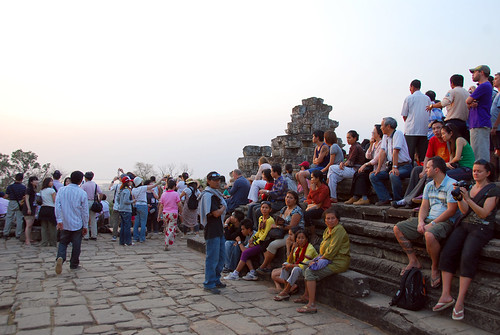
The peanut gallery waiting for the sun to go down.
Speaking of the sun, we did do the whole “Angkor-Wat-at-sunrise” thing. This is a very popular activity for tourists, so it’s not exactly the serene, spiritual experience you might desire. Just don’t expect to be alone out there (you won’t be). Still, it is beautiful, despite the 5AM wake-up time (ouch!).
In addition to the grandeur of the temples, the details are what really make the place come alive.
Yes, the temples are touristy. But unlike southern Thailand, we saw a lot more than European and American faces here. There are families that actually live near the temples and sell to the tourists that visit the park. On that note, let’s have a word about the children.
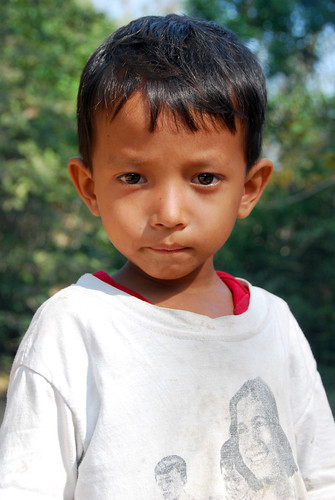
This little guy stared at me (just like this) until I shot this photo and showed him the screen. Then he broke out into the biggest, most beautiful smile.
Oh my, are they beautiful. But heartbreaking too, as each one is begging you to buy whatever they happen to be selling (cold drinks, bracelets, fresh fruit, wind pipes…wtf?). It’s hard because their families have sent them out to sell to tourists because they know it’s hard to say no to a child. But they should be in school and you don’t want to give them an economic incentive not to get an education. These are the extremes of Cambodia on display: poverty set amongst the beauty of the people and the magnificence of the temples. One of our tuk-tuk drivers told us that a person working for a company in Cambodia makes about US$30 a month, whereas a tuk-tuk driver can make US$10-15 a day. Plus, we have heard that corruption here is rampant, so any foreign money coming in to help eradicate poverty will inevitably line the pockets of many politicians before it reaches the people who really need it. Since we left Siem Reap, I have found myself wishing that we would have stayed longer, not only because we really liked the town, but also to have a chance to visit an orphanage or volunteer in some other way. Even though I regret not giving back to Cambodia beyond my US dollars, I’ve been inspired to keep my eyes open for opportunities that may come up as we get further along in this trip.
From Penang, we hopped on a bus towards Kuala Lumpur. In SE Asia, you don’t book your bus online or at the station like we do in the States—there are travel centers everywhere and you can usually book through your hotel or guesthouse too. The result is you never really know what kind of bus you are going to get. Will it be big and roomy? Clean or dirty? Bathroom? We lucked out and got an amazingly comfortable bus to KL. Best of all, the interior was amazing: red upholstered seats covered in multi-colored stars, with matching blue upholstery on the ceiling. The bus also had draped curtains with tassel fringe. Classy.
The one downside to our us trip was that the bus never stopped for food. So we spent 6 hours on a bus with nothing to eat but sugar crackers. If you are reading this blog, you probably know me and Jeremy. And if you know me and Jeremy, that means you know that we don’t do so well without food. We were starving by the time we found a guest house and dropped off our bags. Luckily the Penang is not the only place with great Malaysian food!

The food stand next to our guest house with “famous beef noodles.”
We were only in KL for two nights en route to Cambodia. Our original plan was to fly over to Malaysian Borneo from KL in order to dive Sipadan. However, we found out that the visibility in this dive area vastly improves as you near April, and we didn’t want to spend a bunch of money and have another Great Barrier Reef experience (where we had a lot of fun but the diving was perhaps not as good as it might be during another part of the year). So, we will return to Malaysia at the very end of our SE Asia trip. Since we fly through KL to get to Sipadan, we will spend another night or two here and get to know the city better.
During our short stay, we did get over to KL’s biggest landmark and tourist attraction: the Petronas Towers. They were the tallest buildings in the world for a while, until a building in Taipei knocked them off their throne. Apparently they blend modernism with traditional Islamic imagery…we don’t really know much about Muslim iconography, but we do know that these buildings are really beautiful, especially at night.
There is a giant upscale mall underneath the towers, and Jeremy bought a new pair of flip flops there. We walk a LOT and the only shoes we’ve worn in SE Asia are our Rainbow flip flops (it’s too hot to wear real shoes). You can buy cheap flip flops in the street markets, but we figured it might be worth it to splurge on a real pair since J will be wearing them pretty much every day for a year. He found a pair of Reef flippies that fit his feet really well and wore them out of the shop. All the way back to the hotel, he was raving about how much better they were than his Rainbows, how crazy he was to be wearing the Rainbows for so long, how insanely awesome his Reefs were. He really likes his new flip flops! I never knew what a huge difference a pair of sandals could make! I think Jeremy will always have a special spot in his heart for KL…as the place where he discovered the Reef. ![]()
As I mentioned in a previous post, we came to Malaysia because we tried Penang and Mussaman curries in Thailand and loved them. Well, we found out much later that these are not Malaysian curries at all, but Southern Thai curries. So, our entire reason for visiting Malaysia was based on a misunderstanding. No matter, because we loved the food in Penang even more than the curries that brought us here.
Penang is known throughout SE Asia for its amazing food. This owes a lot to the clash of cultures that exists here…Indian spices, Chinese noodles, and Thai herbs flow freely into the Malay dishes. Plus, the food is cheap! We had only 1 restaurant meal the 4 days we stayed here, and ate at food stalls the rest of the time, with our dishes costing between 2 and 5 ringgit (aprox. US$0.50 to US$1.50). Even better, the portions here are small, so we could eat about 6 meals a day (splitting the dish each time, so we weren’t really THAT gluttonous). After losing a few pounds in Thailand from our stomach flu, we could afford to overeat a bit anyway. ![]()
Food stand eating is quite convenient in Penang. Not only is it fast and cheap, but there are usually small plastic tables set up nearby so you can actually eat your meal at a table. Basically, it’s just like eating at an open-air restaurant.
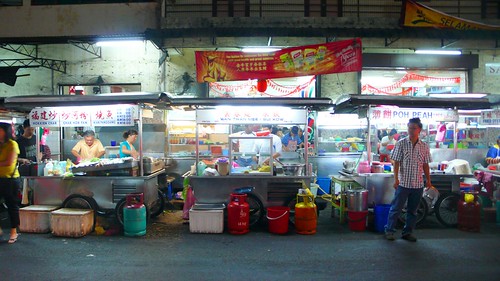
At the New Lane hawker center.
Below is a selection of dishes that we really enjoyed.
Curry Mee (Malaysian)
Curry mee is a noodle soup with a coconut milk base. This was by far our favorite dish in Penang—so nice we ordered it twice! Interestingly, in Penang, noodle soups are often made with both egg and rice noodles—two great tastes that taste great together. Curry mee also includes fried tofu, bamboo shoots, cubes of pig’s blood (thankfully, we did not know what this was until later…we tried it and didn’t mind it), and snails (didn’t know what this was either when we ate curry mee…tried one, didn’t like it). It is served with a spoonful of hot sauce on top; you drop the spoon in and mix the hot sauce with the curry broth. It is really spicy and rich and delicious. My mouth is watering just writing this.
Popiah (Malaysian)
This is a small roll filled with some sort of brown sauce (maybe hoisin?), lots of shredded yam bean, dried bean curd, and some sort of meat (we read that it was crab meat, but we think ours was filled with chicken). All of this is wrapped in a fresh spring roll skin. Because of the yam bean, this roll is super juicy, not dry like most spring rolls. It is absolutely incredible…we were shocked by how tasty and delicious it was, especially since it doesn’t really look like much on the plate. ![]()
Chicken Rice
Again, another winner. This is simply roasted chicken (sometimes they sell it with boiled chicken—be sure to find a stall that sells roasted chicken since it is much, much tastier) with bean sprouts and green onion served with a scoop of rice, a small bowl of chicken broth, and an amazingly delicious chili sauce with ginger. Mix all of these elements together, and you get one of the best meals we had in Penang. Sounds simple, but the flavors are each so distinct that it makes this dish a standout.
Claypot Chicken Rice
This dish is quite different from regular chicken rice. The claypot is placed on top of the range, with a scoop of rice and a dark brown liquid (we think it is a very light soy sauce mixed with other goodies) thrown in. It also includes chinese sausage, stewed chicken, and an egg. This dish sounds like it might be heavy (due to the soy sauce mixture that the rice is cooked in), but it surprisingly light. Also, the crispy rice at the bottom of the pot is a delicious treat.
Nasi Kandar (Indian)
Nasi kandar is a generic term for “Indian stuff with rice.” You can choose any number of curries, fried treats, roasted meats or veggies to go with your rice. They sell it everywhere in Penang and you could probably eat nasi kandar at every meal and never have the same thing twice. We actually had this dish in the ferry building in Langkawi. It is chicken masala, curried rice, and cucumber and pineapple salad.
Congee/Jook (Chinese)
Congee or jook is Chinese rice porridge, and I grew up eating it on the weekends for breakfast. I used to eat it plain with sugar, but in my adulthood I have come to enjoy salty jook. Jeremy loves this stuff too, maybe even more than I do. In Penang, we had it with salted and preserved eggs and chinese fried dough. We will be eating a lot of this when we get to Taiwan. Stay tuned. ![]()
Roasted Chestnuts
There are two roasted chestnut vendors at the Chowrasta market off of Jalan Penang. I remember when I was a kid my dad used to make roasted chestnuts and I always loved them. They are mildly sweet and make a great snack.
Char Siew Noodle Soup and Stir-fried Noodles
We happened upon this food stall one night and had a quick and simple dinner. It’s just a simple noodle soup with barbecued pork and veggies on top. The stir-fried noodles have some soy sauce mixture poured over them. It’s really yummy.
Roti Cenai (Indian)
Unfortunately, I guess I forgot to take a picture of this dish. It is an Indian bread fried in ghee that can come stuffed with goodies like egg and onion. You get a curry dipping sauce with it and it is greasy and delicious.
Sugar Cane Juice
Not a meal, but worth mentioning anyway. You can all kinds of fresh-squeezed juices in Penang (we also really liked the starfruit juice). If you take it “to go,” they dump it in a bag with some ice—no plastic cups here.
Not every meal we had was insanely good. There were a few dishes we tried that we didn’t love. Here are some of those meals:
Hokkien Mee
Hokkien mee is a spicy noodle soup with prawns and Chinese cabbage. We didn’t love this dish because it is very fishy tasting, even for us (we love fish). We think the broth is made with dried shrimp, which gives it a very strong, almost smoky flavor.
Char Kway Teow
This is basically a stir-fried noodle dish with flat rice noodles, chinese sausage, bean sprout, and egg. It was fine, but not one of the standouts. Maybe if I tried one of the other char kway teow vendors?
Assam Laksa
Sorry, again, no photo. We may have ordered this from the wrong place…we got it from a Muslim hawker stand because they were the only ones not harassing us to eat at their joint. Laksa is not a Muslim dish, however (it’s Malaysian), so it may be better at another food stand. Also, it’s worth noting that laksa in Penang is different than laksa elsewhere in Malaysia—the broth is much fishier and there is less coconut milk used.
We want to give a special shout-out to the people running the food stands. These people are amazing! They are super fast, they work long hours, and they often speak several different languages. We should have gotten video of some of these people working…their hands move so fast, they look like martial artists! Hi-ya!
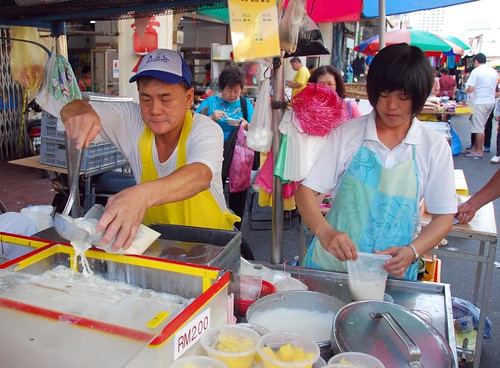
Soy milk vendor at Chowrasta market.
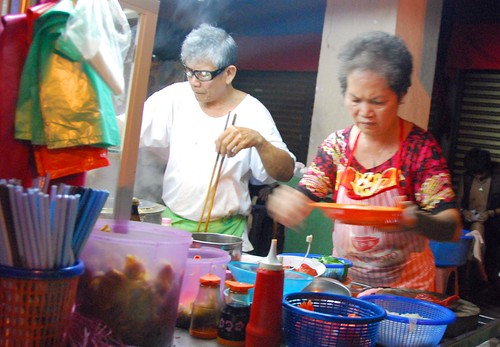
Char siew noodle soup stall on Lebuh Chulia.
As you can probably tell, we loved Penang. The food is great, we love the mix of different cultures all living together peacefully, and best of all, there are not that many tourists here as compared to other parts of SE Asia. We had a nice time climbing and swimming in southern Thailand, but we were troubled by how much it seemed like a playground for Europeans and Americans. We were longing for a little more interaction with the locals and we got that in Penang. Malaysia rocks!
While we were in Ton Sai, we had a couple of really delicious dishes (Penang and Mussaman curries) that we learned were of Malaysian origin. Southern Thailand borders Peninsular Malaysia, so there is a lot of Malay food in Thailand and vice versa. Since Ko Lipe is so close to Malaysia already, we decided to head over…our first stop would be Pulau Langkawi (a resort island) en route to Penang, which is famous throughout SE Asia for its food. From there we would head to Kuala Lumpur. Jeremy really wanted to check out KL because he likes the name. Also, it is a major airline hub, allowing us to fly back to mainland SE Asia for cheap. So there you have it: we went to Malaysia for (1) the food, and (2) because its capital city sounds like “Lumpy Koala.” We are very picky and discerning travelers over here at 12FOOT3.
All over Pattaya beach, there are signs advertising a “45 minute speedboat” to Pulau Langkawi, an island on the very northern tip of Peninsular Malaysia. We paid about 1200 baht (approx. US$35) each for the ride over, and we were looking forward to the quick and easy hop over to Malaysia.

Bye bye Ko Lipe: Pattaya beach as the Langkawi boat speeds away.
OK, not so fast: first of all, the trip actually took more like an hour and a half (and the boat left late). We have found that in SE Asia, time estimates can be quite off…what is advertised as a 5-hour bus ride really takes only three; a 45-minute boat ride means you get there an hour and a half later. This wouldn’t be so bad except that this speedboat ride was The. Bumpiest. Boat. Ride. EVER. There were about 10 of us on the boat and we all sat around looking at each other nervously as the boat crashed repeatedly against the waves. At times, it really seemed like the boat could break apart from the turbulence. And, they probably should have warned us, like they do at Sea World, that if you sit in the first 6 rows, you may get very wet. Well, we all had front-row seats and were completely drenched several times throughout the trip. I consider it a minor miracle that no one got sick on the ride.
We finally got on land in Langkawi (where they actually have a pier! No wading through the surf to get to shore here) and happily jumped ashore…and waited. And waited. It took about 2 hours for them to process our visas…so, our 45-minute speedboat ride had turned into a 4 hour trip. So much for the quick and easy hop over to Malaysia. ![]()
We don’t really have much to say about Langkawi because we only stayed there for one night. The Malaysian government has put a lot of resources into advertising Langkawi, and it worked…there seem to be a lot of Asian and European tourists on this island. Accommodation and food can be expensive here (compared to other parts of Malaysia)…we paid about 70 Malaysian ringgit for our room (approx US$20) and probably about 40 ringgit (US$11 or so) for food. In fact, the only thing that is not expensive is the beer. It is the one area in Malaysia where alcohol is duty-free, so a beer can cost as little as 3.50 ringgit (US$1).
We spent the afternoon on the beach. Malaysia is a very Muslim country, and it was interesting watching teenagers jump in the water in full clothing and head scarves.
The water here is murkier than it is on the Ko Lipe side, and the beach more crowded with people and vendors trying to sell tourists silly “adventure” experiences like parasailing or riding on something called a “big banana” (a giant inflatable tube that you ride like a horse) being pulled by a speedboat. We preferred Ko Lipe to Langkawi. ![]()
The next day, we took a ferry from Langkawi to Penang. This boat was thankfully much calmer than the speedboat we took from Ko Lipe. And they showed the Lindsay Lohan version of “Herbie the Love Bug,” which Jeremy was totally entranced by. There were also really helpful signs instructing us on how to put on a life vest in case of emergency.
The food of Penang deserves its own post (coming up next), but we did do stuff besides eat in Penang (though not much more). We found a great old colonial guesthouse on Love Lane in Penang called Old Penang Guest House. At 50 ringgit (US$14), it was on the more expensive side, but we loved it so much and the people running the place were so nice that we didn’t mind the extra cost. Plus they had free wi-fi, our room had A/C, and there was electricity around the clock. Luxury!
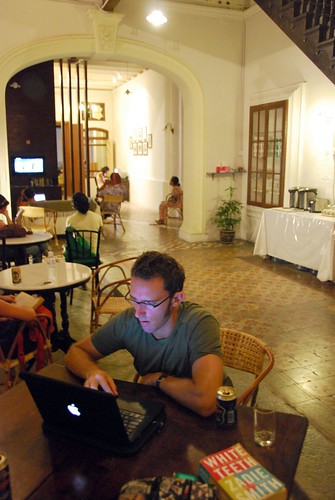
The common area at Old Penang Guest House.
We just happened to come into town at the end of the Chinese New Year celebration…there are lots of Chinese in Malaysia and the festival here is huge, lasting 7 days. The streets were filled with people watching lion dance performances and generally celebrating the new year.
The really wonderful thing about Penang is the clash of cultures that exists here—Chinese, Indian, Malay; Hindu, Buddhist, Muslim, and Christian—it’s all here and everyone seems to get along. It’s quite amazing. There is a city walk that you can do called the Street of Harmony walk because it takes you from a Catholic Church to a Chinese and then Hindu temple, on to a Muslim mosque—all in about 3 city blocks. We wandered into Han Jiang Temple one day, where Chinese people were paying their respects to their ancestors at the start of the new year. We decided to take part, so I asked the lady selling incense how to do it, and she taught me (Mandarin comes in really handy in Malaysia) how to burn the incense and paper money at each of the temple urns.
We also took a day trip up Penang Hill one day, where you can ride a trolley up to see views of the city below.
From Penang Hill, you can walk to Kek Lok Si Temple, and absolutely enormous, colorful, and elaborately detailed (some might even say gaudy) Chinese Buddhist temple.
Despite the grandeur of Penang’s temples and its old colonial charm, the real star of the show here is the food. Stay tuned… ![]()
As I mentioned in the previous post, we really didn’t have a plan in place for SE Asia…which in many ways is really good for us (or at least, me)—to learn how to be comfortable with the uncertainty of not knowing where we are going to sleep or even what city we are going to be in the next day. BUT, this also means we spend a ridiculous amount of time trying to figure out what the heck we’re going to do next. We had originally planned to go diving in Ko Phi Phi, but we found out from some people on Ton Sai that (1) Ko Phi Phi is a big, noisy scene full of kids getting drunk and foreign men and their “Thai wives,” and (2) that the diving is better in Sipadan (in Malaysian Borneo)—actually, rumor is that it is the best diving in the world. So, we decided to check out another island in Southern Thailand (island hopping is a big thing here), and save our diving dollars for Sipadan.
Oh, but what island to go to?!? I know, I’m not expecting anyone to throw us a pity party for this quandary…but we really spent a lot of time changing our plans back and forth. For a while, we were heading to Loh Liang, a tiny island with one resort where a lot of climbers go from Krabi. Then we thought maybe we should dive in the Similan Islands. Finally, we decided (after hearing rave reviews from several people we met on Ton Sai) to head to Ko Lipe, a small island at the very southwestern tip of Thailand in Ko Tarutao National Park. And we were sooo glad we came.
We took a long tail boat from Ton Sai to Ao Nang, a bus from Ao Nang to Pakbara, and a speed boat from Pakbara to Ko Lipe. There are three main beaches in Ko Lipe: Sunrise beach, Sunset beach, and Pattaya, with the last beach being the busiest. One of the gals in Ton Sai said we should stay at Coco Resort on Sunrise beach, and it didn’t take us long to realize that we basically had the best spot on the island.
The strip of Sunrise beach right in front of Coco Resort was quiet, pristine (look at that water!!!), and peaceful; even a few meters down the beach was more crowded and noisy. Plus, Coco Resort was a lovely little place run by a Thai family…we negotiated a bamboo bungalow for 900 baht per night (approx. US$26) the first night, and it seems like this might be one of the cheaper places on the island to stay. The bamboo room was very atmospheric but the floor felt like you could fall right through it. Later we would see that half the posts supposedly supporting the bungalow were several inches too short and didn’t reach the ground (scary!!!).
So the following day we moved to a concrete bungalow (700 baht/US$20 per night), which felt a little more solid. ![]()
We spent three days here swimming, reading on the beach, and generally enjoying the beauty that is Ko Lipe. And, on one particularly inspired day, we watched the sunrise on Sunrise Beach:
And the sunset on Sunset Beach:
We had some great dinners here too…there is a place at the very end of Pattaya beach where you can walk up and choose your fish from a huge platter of iced seafood treats. They weigh it, grill it, and serve it to you at your table on the beach. YUM!
We LOVED Ko Lipe!
We really didn’t have a plan as to where we were going after we arrived in Bangkok…and, as we’ve discovered, even if you *think* you have a plan, SE Asia has other ideas for you. ![]() Jeremy remembered that a friend of ours from SF, Jeremy Sugerman (I will refer to him as “Sug” to avoid confusion), is often in Thailand for 6 weeks around January/February, so we emailed him…and sure enough, he was in Krabi, a small beach town in Southern Thailand near Phuket which is known as “Climber’s Paradise” due to the fact that it is surrounded on all sides by enormous limestone cliffs. We’ve heard about Krabi for years because many San Francisco climbers often visit. That, combined with the fact that Sug was there, was all the reason we needed to head down south.
Jeremy remembered that a friend of ours from SF, Jeremy Sugerman (I will refer to him as “Sug” to avoid confusion), is often in Thailand for 6 weeks around January/February, so we emailed him…and sure enough, he was in Krabi, a small beach town in Southern Thailand near Phuket which is known as “Climber’s Paradise” due to the fact that it is surrounded on all sides by enormous limestone cliffs. We’ve heard about Krabi for years because many San Francisco climbers often visit. That, combined with the fact that Sug was there, was all the reason we needed to head down south.
We booked a flight to Krabi in Bangkok. In SE Asia, you can book airline tickets the day before you want to leave, and they’re still pretty cheap. Also, the price a travel agent can offer can be cheaper than one you can find on the internet. We spent about 2500 baht (approx. US$75) per person for a one-way flight from Bangkok to Krabi. This isn’t a rock-bottom price, but given the fact that the bus ride to Krabi is 10 hours long, we decided to spend the dough.
Sug was staying on Hat Ton Sai in Krabi, a tiny beach area accessible only by boat. So, after we got off the plane in Krabi, we took a bus to Ao Nang, where we boarded a longtail boat to Ton Sai. That’s a lot of different transportation for one afternoon! It was low tide where we got to Ao Nang, which meant we had to walk through the water to board the boat since they can’t get to shore (and there is no pier). Thank goodness we have hybrid wheelie/backpack bags! We had agonized over this decision before we left on our trip—Jeremy just wanted a wheelie duffel bag and I insisted that he find a bag with backpack straps. In true Hermann fashion, Jeremy found the bag that worked for him, and then rigged up a backpack using detachable straps. Hey, whatever works. ![]() I felt really bad for the people who didn’t have backpacks. None of us expected that we would have to haul our bags across the beach and then through the water, but it was extra tough for the non-backpackers and some of their bags got quite wet.
I felt really bad for the people who didn’t have backpacks. None of us expected that we would have to haul our bags across the beach and then through the water, but it was extra tough for the non-backpackers and some of their bags got quite wet.
The boat ride into Krabi is really beautiful. Krabi is a stunning place—it is quite dramatic with all the rocky cliffs—and the landscape is very different from other parts of Thailand.

View of Rai Leh beach from Thai Wand, Ton Sai is the next beach over (to the left).
Sug had hooked up a room for us at Dream Valley Resort, where he was staying. Our bungalow was cute from the outside, but quite basic inside, and at 650 baht (approx. US$18.50) per night (including breakfast), it was one of the cheapest places to sleep. This means Ton Sai is not the most economical accommodation in Thailand, but it is certainly a lot cheaper than the next beach down, Hat Rai Leh, where rooms can go for at least 2000 baht per night. Ton Sai is run on generators, so you only have electricity in your room from approx. 6:30PM until 8AM. At least you can run the fan at night! A few more details: the toilets do not flush (you have to dump a bucket of water down the loo), the showers are cold, and the beds are HARD! Even for Jeremy and I (we love a firm bed), these beds were like concrete slabs. So, very basic indeed!
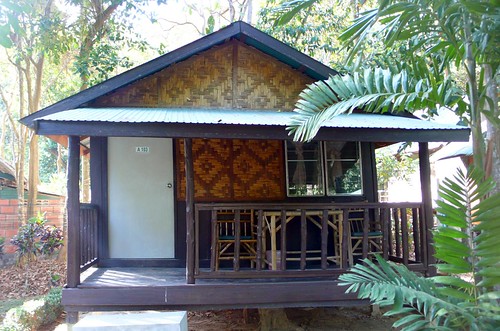
Our bungalow at Dream Valley Resort.
But most people are not in Ton Sai for the accommodation: they are there to climb. Literally, every rock wall you see has been bolted and there are people climbing it. It really is a sport climber’s paradise. Given that Jeremy and I have not been on a wall for over a year (and probably at least 5 years since we’ve been on real rock), we didn’t pack any gear with us on our trip. But it’s easy enough to rent shoes and a harness here on Ton Sai.
Our first day out, we went with Sug, Janet (a great gal—Sug’s friend visiting from SF), and Sug’s friends Chris and Kindy (who have a gorgeous house in Rai Leh) to Thai Wand wall, and then to another location (I forget the name). NOTE: We took to calling Sug the “Mayor of Ton Sai,” because he knows EVERYONE! He has come to Krabi for the last 9 years (and he stays 4-6 weeks each time), so he truly is the mayor.
And, the awful truth: I was pumped out after two climbs. Jeremy managed to finish 4 climbs that day.
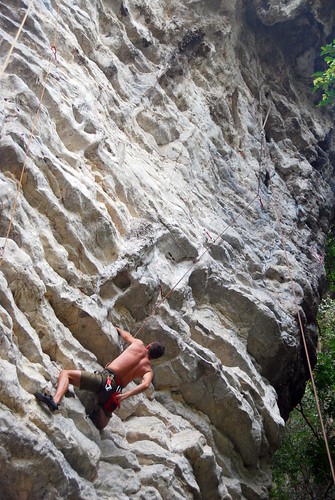
Jeremy on…some difficult route.
We ended the climbing day with beers at Sawasdee bar at sunset.
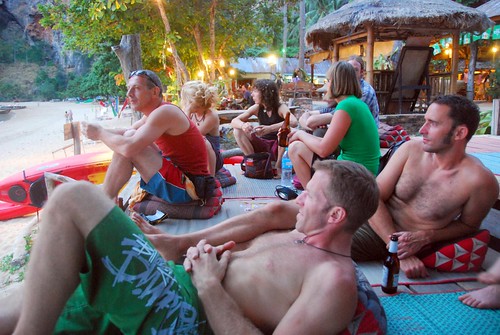
The Jeremies watcing the sunset from Sawasdee.
In fact, this is part of the general “schedule” of events every day on Ton Sai: get up early, eat breakfast, climb, lunch at the chicken ladies (some women who have food stalls by the beach selling yummy grilled chicken), climb more, beers at Sawasdee bar at sunset, followed by dinner at Banyan Tree.
Jeremy and I couldn’t take part in this daily routine the following day because we were SORE. Oh my, a year off the rock and we were little weaklings. So, we decided to go out sea kayaking. Hey, guess what? It turns out that the same muscles you use to climb are the ones you use kayaking. So, it wasn’t much of a rest day for us. ![]()
Jeremy and I planned on staying in Ton Sai only about 3 days or so, but then, as I said earlier, SE Asia had other plans for us. Jeremy came down with a case of “Ton Sai belly,” a stomach virus that kept him bedridden for about 24 hours. So far, I had escaped the virus (Sug had it the day before), so I went out climbing at Eagle wall with Janet and a cool German girl named Hannah.

Taken from the summit at Eagle wall.
Again, my limit was two routes, but this time it wasn’t my muscles but my belly: I felt the rumblings and the cramps…I had came down with the virus too. ![]() Let me tell you, it’s no fun being stuck in a bungalow with no air conditioning (much less electricity) when you’re sick. And, the bed felt even harder than hard with all our achy muscles against it.
Let me tell you, it’s no fun being stuck in a bungalow with no air conditioning (much less electricity) when you’re sick. And, the bed felt even harder than hard with all our achy muscles against it.
But honestly, it wasn’t so bad for our first time being sick. It only lasted a day and the cramps definitely weren’t as bad as the times I had food poisoning. Besides, we need to toughen up our stomachs if we are going to make it through Asia.
So, we ended up staying in Ton Sai a little longer than we wanted to, and I have to be honest here: even though the climbing is great, I still can’t understand why all the climbers think it is heaven on earth in Ton Sai. Many people literally stay for months and they can’t even fathom why you would want to leave. I mean, it’s nice, but the beach is a bit polluted and during low tide the shore is muddy and littered with dead coral. Plus, Jeremy thinks water table is contaminated (the water coming out of the sink is quite stinky), which basically means there is no way you can stay healthy on Ton Sai, because everything is washed in this water. Honestly, it kind of grossed us out a bit. Maybe I am being too prissy, but I just thought, “Thailand HAS to get better than this.”
But I don’t want to end on to sour a note. We had a great time climbing again and it was fun hanging out with Sug and meeting Janet. We met a lot of cool people who helped us figure out where to go in SE Asia and how to get there. But in the end we were glad we were only spending a few days in Ton Sai. ![]()
There is only one flight from Hong Kong into Bangkok via AirAsia each day, and that flight arrives in Bangkok at 11PM. We knew that by the time it we took the taxi/train/bus into the city, it would be quite late. And here’s the kicker: you can’t really make a reservation in SE Asia. Well, you can, but not if you are a budget traveler. We read in the Lonely Planet that most budget hostels/hotels/guesthouses don’t take reservations, and even if they do, sometimes you show up and your reservation (along with your down payment) has mysteriously disappeared. So, your best bet is to just show up and start looking for a room in one of the guest houses. It made me a little nervous that we didn’t have a place lined up to stay for the night, but that’s how it is here in SE Asia, and the uncertainty is part of the adventure here.
BTW, if you are ever considering traveling around SE Asia, we HIGHLY recommend that you pick up a Lonely Planet. Jeremy and I aren’t really the guidebook types, preferring to just figure stuff out along the way, but the little yellow book is indispensable here. Seriously, there is just so much you have to figure out about each country (buses, places to stay, local customs, food, etc.)—much less each town in each country—and there is no way you can figure all that out on your own, no matter how many people you talk to. Of course, we don’t take it as gospel—we’ve already found some of their comments to be incorrect in our experience, but the LP does help point you in the right direction. For example, the LP “recommended” hostels are probably pretty nice, but we haven’t stayed in one yet, because they are usually completely booked with other travelers (who also have their own copies of LP). Typically, we just look in the guide to get an idea of where the budget hostels are concentrated, and we head to that area, stopping by each guesthouse to enquire about rates and vacancy.
So that’s exactly what we did when we arrived in Bangkok…at midnight. We headed to Soi Rambuttri, a smaller alleyway off Khao San Road. We started at one end of Soi Rambuttri and stopped at each guesthouse (and there is pretty much one guesthouse every few feet on this road), asking if they had any beds available for the night. We must have asked at least 15 places for a room until we found a vacancy at Baan Sabai, and we snapped the room up right there on the spot. So it kind of looked like a prison cell and the shared bathroom didn’t come with toilet paper (actually, we would come to find out—none of the budget rooms in Thailand come with toilet paper), but it was a place to lay our heads for 290 baht (approx. US$8.25), and that was good enough for us.
Many of the guesthouses in Thailand have little restaurants attached, and in the morning, we headed down for a much-needed cup of joe and people-watched from our guesthouse cafe.
A couple things we noticed:
1. In Thailand, the street sweepers are people rather than large machines. A huge swarm of people with bamboo brooms came by sweeping the floor, followed by a large water truck flooding the ground, followed by more sweepers. The street was spic and span afterwards, too.
2. There were a shocking number of people drinking huge beer Changs for breakfast. I should mention that these people were travelers, not Thais.
After breakfast, we moved to a new guesthouse (though to be fair, we saw some of the other rooms at Baan Sabai on our way out and they looked pretty nice). We moved down the street to Bella Bella House, and our room, while nondescript, did have its own bathroom with a hot shower (though we still had to buy our own toilet paper) for 420 baht (approx. $12). And, it did have a nice view of the neighboring temple:
We weren’t in Bangkok very long. Like most people, we stayed only a few nights one our way to the islands. But, we did walk around and see a few temples:
As well as a 40 foot standing Buddha:
And we got to meet Oak, a super nice Thai guy we met through Robert, who met him through our friend Gabe. BTW, Oak runs a website that sells Thai kickboxing gear: http://www.muaythaistuff.com. Get all your, um, Thai kickboxing gear from him!
Oak took us out on the town, and we finally saw Khao San Road, which was total mayhem! There were hundreds of tourists on that tiny street, along with food vendors, contortionists, singing transvestites, people selling clothes…you name it, you can find it on Khao San. We couldn’t believe this carnival so close to our quiet little alley, and we thanked our lucky stars we weren’t staying on this street (I’m not sure how you would sleep with all the lights and noise).
We’ll come back to Bangkok, perhaps in a few weeks on our way to Burma, perhaps in two months on our way out to Taiwan. Oak has kindly offered for us to stay with him when we come back through, and once again, we are surprised and touched by amount of generosity we’ve been shown so far on this trip. If Thailand can foster this kind of hospitality towards it’s visitors, it’s gotta be a great country…even if you do have to BYOTP. ![]()
We’re about two months into our trip now, and from here on out, the only English-speaking country we will visit is Ireland. We’re headed to Asia—southeast Asia, to be exact…the land of squat toilets, cold showers, mosquito nets, and delicious food. But first…we spent one night in Hong Kong on our way to Thailand, and though 24 hours doesn’t seem like a very long time, it felt like we managed to do quite a bit during our short stay there (we plan on staying a little longer when we fly back through Hong Kong on our way from SE Asia to Taiwan).
We flew from Cairns to Hong Kong on our around-the-world ticket, and then purchased tickets from Hong Kong to Bangkok via AirAsia (http://www.airasia.com), a low-cost Asian airline. It cost us about HKD$2100 (approx. US$300) each for the roundtrip tickets. This is a little more expensive than we expected it to be, but it was the best deal we could find.
We booked a great room at the Mingle Techotel via wotif.com (a GREAT last-minute hotel resource that Jasmine told us about) in the Tsim Sha Tsui district of Kowloon. Random funny: I thought we booked a room at the Mingle “Tee-cho-tel”. It took me a minute to realize it was actually a “tech hotel,” not some weird Mayan hotel in the middle of Hong Kong.
We got in a bit late—it was about 10PM by the time we took the train into Kowloon and then the taxi to our hotel, but the place was absolutely alive like it was a Friday night (it was Tuesday). The streets were packed with people shopping (the stores don’t close until about 11PM here), eating at the food stalls, and generally hanging out with friends.
We walked around Tsim Sha Tsui and headed towards the boardwalk, where you can see Hong Kong across Victoria Harbour.
We were pretty exhausted from our long flight and headed back to the hotel after an hour or so. But when we laid down and turned on the TV, what was on but the inauguration! We had to stay up and see our new president get sworn into office. So, right there in our Hong Kong hotel room, we watched as Barack Obama took the presidential oath. It’s a strange thing traveling as Americans during this time…Jeremy and I have been to South and Central America, Asia, and Europe before, but this is the first time as travelers that we feel proud to be Americans. Everywhere we have been, people have been very supportive of Obama. We felt really patriotic watching the inauguration, thinking that we were sharing this moment with millions of people, not just in the US, but around the world. It was 1:30AM Hong Kong time when Obama finally finished his speech, but it was worth the wait. ![]()
The next morning, rested and reassured that things were getting kicked off back home, we enjoyed a great breakfast—I had jook (they call it congee here) with pork and pickles, Jeremy had wonton soup. Yum!
Jeremy and I split up for the day—he wanted to see if he could exchange his North Face day pack (which is already falling apart after 2 months), and I wanted to go shopping (it’s official, I am sick of my clothes). Hong Kong is a shopping haven…in fact, I’m not sure what else people do in Hong Kong! It seems like people are just buying things all day long. So, I headed towards Mong Kok, while Jeremy took the subway into Hong Kong.
I found a street market with lots of clothing stalls and found a few cute items. Of course, I had to bust out the Mandarin when negotiating (even though most people speak Cantonese in HK)—I figured that speaking English can only end in a higher price. I may have gotten totally robbed, but both the saleslady and I were happy with the deal so that’s a good bargaining session in my book.
I also had a chance to sample some of the Hong Kong street food while I was out and about. Some of it was a little scary-looking (fish balls stewing in a curry sauce?), but I was able to point at some delicious deep-fried dumplings and some pork meatballs on a stick. Yum!
Jeremy had a good day downtown too, though we were both pretty exhausted after our day on the town. The sheer number of people in this city makes simply walking the streets a huge effort. This is good practice for the rest of Asia, though…at least there are sidewalks in Hong Kong!
Thanks for the great day, Hong Kong! We’ll see you soon…
